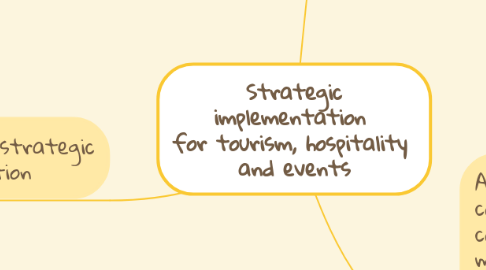
1. Aspects of strategic implementation
1.1. Resources
1.1.1. The successful management of a strategy is likely to depend on the management of many resource areas.
1.1.2. Resources are developed and then controlled to ensure they meet the needs of the proposed strategy.
1.1.3. Financial planning takes the form of financing the proposed strategy
1.1.4. Human resource planning (see Chapter 4) involves projecting the human capital required for the successful implementation of the proposed strategy.
1.1.5. Physical resource planning is slightly more complex than financial and human resource planning.
1.1.6. Intellectual resources – inputs that cannot be seen and touched – can be the most important resource inputs of all
1.2. configuration of culture and structure
1.2.1. Cultural suitability
1.2.1.1. We encountered the concept of organizational culture in Chapter 4. Strategic implementation usually involves making an assessment of the suitability of a culture to undertake the strategy.
1.2.2. Miles and Snow’s typology and cultural postures
1.2.2.1. Defender cultures are suitable for organizations that exist in relatively well-defined market areas and where improving the position in existing markets is the most appropriate strategic option
1.2.2.2. Prospector cultures, in contrast to defenders, are continually seeking out new product and market oppor- tunities.
1.2.2.3. Analyser cultures exhibit features of both defenders and prospectors.
1.2.2.4. Reactor cultures can sometimes lack strategic focus and are consequently sometimes accused of being blown around’ by changes in their environments.
1.2.3. Cultural differences between the current culture and what is required for a strategy is one of the most important aspects of strategic implementation.
1.2.4. Structure
1.2.4.1. Height refers to the number of layers that exist within the structure.
1.2.4.2. The ‘width’ of organizational structures refers to the extent the organization is centralized or decentralized.
1.2.4.3. The complexity of structure is usually taken to mean the extent to which the organization observes a formal hierarchy in its reporting relationships.
1.2.5. Methods of divisionalization
1.2.5.1. There are five common methods of divisionalization.
1.3. Change
1.3.1. Inertia – identifying barriers to change
1.3.1.1. Those affected by the change and resisting it may do so because they:
1.3.1.1.1. Lack understanding of the details
1.3.1.1.2. Lack trust in respect to management.
1.3.1.1.3. Have a fear – Particularly in respect to their personal position or their social relationships.
1.3.1.1.4. Have uncertainty about the future
1.3.2. Understanding change – Kurt Lewin’s three-step model
1.3.2.1. Unfreezing Preparation for change
1.3.2.1.1. Moving Bringing about the requisite change
1.3.3. Understanding change – the urgency and nature of change
1.3.3.1. How urgent the need for change is – A market crisis will typically bring about an urgent need for rapid change whereas preparing for the introduction of a new legal regulation in five years’ time will usually allow change to be brought about more slowly and perhaps more painlessly.
1.3.3.2. How much inertia is evident within the organization’s culture – The time taken to unfreeze the inertia in some organizations will necessarily take longer than in others.
1.3.4. The process of leading and managing the changes
1.3.4.1. Management is about planning, controlling, and putting appropriate structures and systems in place; whereas ● leadership has more to do with anticipating change, coping with change, and adopting a visionary stance.
1.3.5. The role of the ‘change agent’
1.3.5.1. ● develop a shared vision for change emanating from the task teams; ● foster consensus for the new vision by giving support and encouragement; ● replace managers who cannot work under the new system; ● spread revitalization to all departments without pushing from the top; ● institutionalize change through systems and procedures; and ● monitor and adjust strategies in response to problems.
2. Implementation and the strategic process
2.1. Implementation is the system-wide action taken by firm members aimed at accomplishing formulated strategies
2.2. the fact that successful implementation is key to a successful strategy has long been recognized.
3. A methodology for communicating, coordinating and measuring strategic implementation
3.1. The need for a practical and coherent implementation technique
3.1.1. How should the strategy be spread (or cascaded as it is often termed) throughout the organization? ● How should the implementation (in a practical sense) be coordinated, managed and monitored?
3.1.2. Successful implementation of strategy involves all parts of an organization being successfully aligned to meet the strategic objectives that have been set as part of the strategic process.
3.2. Introduction to the Balanced Scorecard
3.2.1. A measurement gap
3.2.2. A strategy gap
3.2.3. objectives, measures and targets to: ● the total organization; ● strategic business units; ● individual operational teams; ● individual members of staff.
3.2.4. Consequently BSC represents a methodology for implementation that: ● has a high degree of visibility and can easily be understood; ● can be easily and consistently communicated to staff and other stakeholders; ● offers a high level of consistency in its approach; ● can be ‘cascaded’ to all parts of the organization; and ● produces tangible and measureable outcomes so that the success (or otherwise) of strategic implement- ation can be assessed.
3.3. The Balanced Scorecard as a part of the strategy process
3.3.1. The process involves: ● identifying key components of operations; ● setting goals for them; and ● finding ways to measure progress towards their achievement.
3.4. The Balanced Scorecard in practice
3.4.1. A typical scorecard normally includes four components: ● a financial perspective; ● an internal business perspective; ● a customer perspective; and ● an innovation and learning perspective.
3.4.2. For each component the organization has to identify a number of: ● objectives (or goals); ● measures for gauging the degree of goal attainmetn ● targets which identify progress towards achieving the goals; and ● initiatives (or priorities) within the period.
3.5. Balance Scorecard – potential difficulties
3.5.1. Mistaking data for useable information
3.5.2. Failing to get the support of employees for the management system
